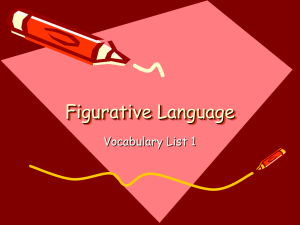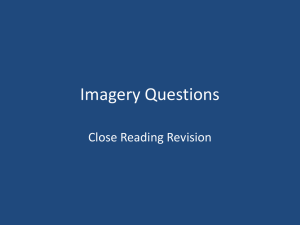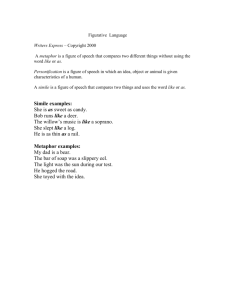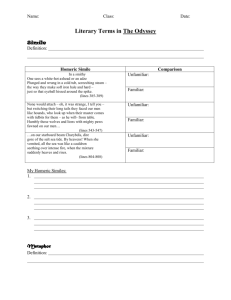Imagery - Wallace High School
advertisement
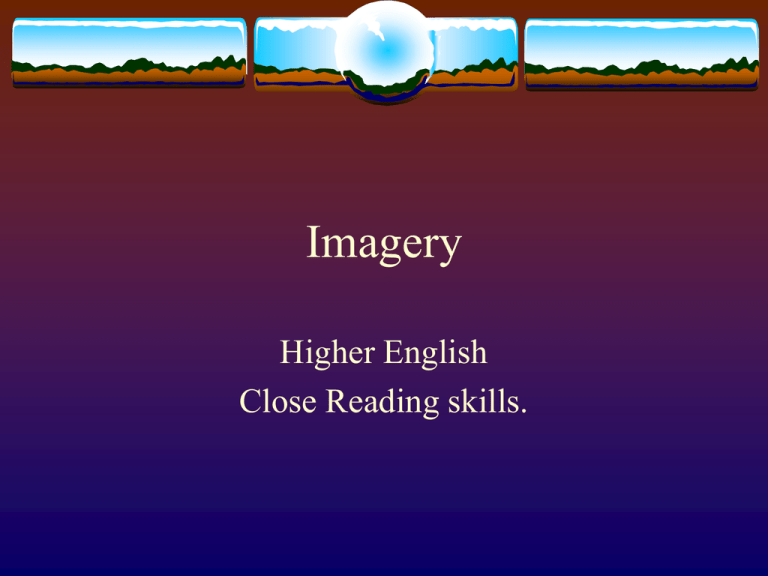
Imagery Higher English Close Reading skills. Common mistakes… Imagery does not mean ‘descriptive writing’ of the kind which uses lots of adjectives to describe scenes and settings in a series of ‘pictures.’ For example, although this passage creates pictures of a scene by choosing accurate descriptive words, it is not imagery as is meant in the context of the Close Reading paper. Down on the level, its pink walls, and straggling roses, and green-painted rain barrel hidden by a thick dusty painting of spruce and larch, was Fin-meoot Cottage, where house martins flocked to nest in summer, and small birds found plenteous food on the bird tables when the winter came with frost and snow. There, way-wise deer went in the windy autumn dawns to bite at fallen apples in the little orchard. Quick quiz 1) 2) 3) 4) 5) 6) 7) What is a simile? What is a metaphor What is personification? What is symbolism? What is metonymy? What is synecdoche? What is transferred epithet? You probably didn’t know what metonymy was… It is the use of a word for a concept with which the original concept behind this word is associated. E.g. When we talk about ‘the crown’, we actually mean…? We substitute the word King or Queen for the word ‘crown’, which is associated with the concept of royalty. Metonymy may be confused with metaphor. Both figures involve the substitution of one term for another. While in metaphor, this substitution is based on similarity, in metonymy the substitution is based on association. Metaphor - The ship plowed through the sea. Metonymy - The sails crossed the ocean. Does this help? word original use metonymic use tongue Oral muscle Language spoken dish item of crockery a course (in dining) the press Printing press the news media What about this? The White House Hollywood Wall Street Holyrood Fleet Street Downing Street So, what’s synecdoche? Synecdoche, where a specific part of something is taken to refer to the whole, is usually understood as a specific kind of metonymy. Sometimes, however, people make an absolute distinction between a metonymy and a synecdoche, treating metonymy as different from rather than inclusive of synecdoche. When the distinction is made, it is the following: when A is used to refer to B, it is a synecdoche if A is a part of B. It a metonymy if A is commonly associated with B but not a part of it. Thus, "The White House said" would be a metonymy for the president and his staff, because the White House (A) is not part of the president or his staff (B) but is closely associated with them. On the other hand, asking for "All hands on deck" is a synecdoche because hands (A) are actually a part of the people (B) to whom they refer. Examples where a part of something is used to refer to the whole "The hired hands are not doing their jobs." "His parents bought him a new set of wheels." "Can I get your digits?" “They don’t even have roofs over their heads.” Similarly, "mouths to feed" for hungry people. Transferred Epithet Where we transfer an adjective which is usually associated with a human being to another object or idea. George Orwell talks about prisoners awaiting execution being in condemned cells, for example. It isn’t the cell but the prisoner who is condemned. Wilfred Owen describes soldiers caught in a gas attack: “fitting the clumsy helmet just in time.” It’s the men who are clumsy, not the helmet. What is imagery? Imagery is a feature of written and spoken language and occurs whenever someone has chosen to use language in a non-literal way. In other words, imagery is a way of describing something symbolically using words to create a visual picture in the reader's imagination. In the Close Reading paper you need to be able to recognise imagery and to consider how successful the imagery is in making you share what the writer is trying to express. Imagery, then, frequently conveys more than just meaning. It is used to heighten the effect of language and is often an extension of word-choice. Normally an image will extend to a phrase or a few words but sometimes it will be longer. Example one 'He ran as fast as a leopard.' This does not literally mean that he ran as fast as the animal, but that he ran quickly and probably gracefully as well. It says more than: 'He ran fast.' In this way an image carries an extra dimension of meaning in subtle ways. As a reader, your task is to get as much from reading materials as you can, by recognising images when you see them and by taking from them the extra layers of meaning that they contain. Example two Here is a very simple image from John Steinbeck's ‘Of Mice and Men:’ 'swinging his hands like a bear' In the book this works as an extended image - where a descriptive idea is consistently used and developed throughout the story. This image gives the reader the picture of a man moving like a slow, lumbering animal. It also implies the idea of a dangerous beast and, as the story progresses, this idea of danger increases. The effect of the image is emphasised by the added layer of menace or danger. Using metaphor and simile Imagery is a figurative comparison between two things which have no literal connection. By comparing things that are not alike, writers use imagery to create a poetic or descriptive impact. Effective imagery works by allowing readers to compare something they are familiar with to something less familiar. There are two very easily recognised forms of imagery: similes and metaphors. Similes are simple comparisons and usually contain the word 'like' or 'as' Simile and Metaphor ' As cool as a cucumber' describes someone who is calm and composed. 'Like a fox in a henhouse' describes dangerous carnage. Metaphors involve comparison like similes but they do so more subtly than similes. Where a simile tends to describe a comparison by making a simple association like the examples above, a metaphor suggests the comparison without stating it explicitly. Metaphor is more complex 'A trickle of aid to sub-Saharan countries came from the West last year instead of the necessary flood.' This imagery illustrates that a natural force like water can be used to describe the way that thirdworld countries are provided with aid. The image relies on the 'trickle' being a slow flow of water inadequate for the purpose of useful aid to the sub-Saharan countries, contrasted with 'flood'; the large volume of support actually needed. Symbolism The use of specific objects or images to represent abstract ideas. A symbol must be something tangible or visible, while the idea it symbolises must be something abstract or universal. (In other words, a symbol must be something you can hold in your hand or draw a picture of, while the idea it symbolises must be something you can’t hold in your hand or draw a picture of.) Golding uses symbols to represent the various aspects of human nature and civilisation as they are revealed in the novel. The conch symbolises order and authority, while its gradual deterioration and ultimate destruction metaphorically represent the boys’ collective downfall. Interpreting Imagery Images and imagery have a purpose. Writers want you to share their thinking as fully as possible. To interpret images and explain how things work, and how well, we have to be methodical. It can help to consider three things: What is the image? Does it work? Why is it effective? Example one 'His wife sat in her fur coat in the car like a drugged bear.' The simile compares the woman in the car with a 'drugged bear'. It works by making a physical comparison; bears have coats like the woman's. And like a bear she is large and ponderous. The simile extends by introducing the word 'drugged'; this suggests that, like a tranquillised animal, the woman might also be dangerous if roused. The image is successful and effective because it goes beyond the physical description of a bear and a woman and introduces ideas of behaviour and character. It's also quite a funny idea. Example two 'We have to get to the heart of the matter.' The metaphor suggests the need to get to the core, or most important part, of something. It works by comparing something of central importance to the most essential organ in the body. Both are vital. The image is effective because the heart is literally the centre of our existence and the comparison emphasises the importance of the essential centre of what is being discussed. Example three 'The generals of World War I were beached, high and dry, above the tide mark of history.' The metaphor suggests the uselessness of the debris that is washed up on a beach. It works by comparing the generals' role in World War I with flotsam and jetsam washed high up on the beach away from the ebb and flow of the tide. The image is effective when we understand the historical context of the generals in World War I. The image of debris above the tide mark stresses the unimportance of the generals and the fact that they are unnoticed, inactive and forgotten by history. Anthropomorphism …attributing human characteristics, feelings, attitudes and qualities to animals. For example, The sea-lion is clapping its hands! Sea-lions don’t have hands and they would not understand the concept of clapping , but the anthropomorphism makes the sea-lion out to be endearing and cute. Example one: which is the best answer? 1 'He was squashed like a frog under the wheels of a bus.' What form of image is this and why is it effective? It is a simile as it uses the word 'like'. It is a simile that compares someone with a frog that has been crushed by a heavy vehicle. It's a simile that compares the fate of someone to the violence of a small creature being crushed by an enormous and heavy object. Example two: which is the best answer? 2 'That girl is like her mother.' Which answer best describes the phrase? This image is a simile because it uses the word 'like'. This is an image where the qualities of two people are being compared. This phrase is noting a resemblance. Example three: which is the best answer? 3 'He has allowed himself to become insulated from reality and have his feathers preened by those around him.' What sort of image is this and why is it effective? This is an image. The prime minister is being kept away from real things in the way that insulation keeps the cold out. This is a metaphor. The image of 'preening' suggests that the prime minister is easily flattered and removed from reality. The 'feathers' also suggests the image of a caged bird or pet; reinforcing the idea of powerlessness. It is a metaphor which describes the people around the prime minister flattering him. Example Four: which is the best answer? 4 'I fear we have wakened a sleeping giant, and his reaction will be terrible.' (Admiral Yamamoto about the Japanese attack on Pearl Harbour). How effective is this image in its context? The image is effective because it compares the angry reaction of waking a sleeping giant to what the Admiral fears will be America's response to the bombing. The image is about angering a country (USA) by comparing the attack on their fleet with wakening a giant. The image is of waking a huge person. He will be angry so it is effective. Example five: which is the best answer? 5 'Now, on the lamplit avenue, he stopped and saw his callousness as evil, able to take all beauty from life; the brightness from the moon, the fragrance from roses...' In this image the man's evil is described as something concrete, not abstract. The image suggests that the man's presence is so evil that it can actually take away all the good things in the world around him, such as flowers, moonlight and beauty. The image of the man's evil is effective as Why is this image effective in evoking it is able to suck out the good qualities of the man's character? flowers, beauty and light. Example Six: which is the best answer? 6 'Time to confess. I'm a big fan of Taggart. I have been for years, which I guess makes me old. By now this famed cop series has been transformed into a comfy, raddled old armchair, one which I slump into. The DNA boys have checked out its stains. CID have reached down the back in search of blood-encrusted weapons. In a sense that chair is also, metaphorically, Glasgow. Last night I sighed and sank into its old, familiar deeps. I was ohso deeply disappointed. The show has, over the years been reupholstered more than once.' What is the image? How effective is it and why? The TV police series is compared to an old armchair and his experience of watching it is like settling into a comfortable chair. It is effective because it relates a piece of comfortable furniture that we associate with watching TV to the familiar programme he is setting out to watch. The two things seem well matched. The metaphor compares his familiarity with Taggart over the years with the comfortable armchair in which he is also accustomed to watching the TV series. The series is about police work in Glasgow and the image suggests he is so much part of the show that it he has become part of it. The forensic (DNA) and CID boys have even looked over his chair he has been watching the show for so long. The metaphor is reinforced as an extended image by the use of the word 'reupholstered'. The image is effective because Taggart is about murders and solving crimes and the imagery connects the two in terms familiar to viewers. By describing the DNA and CID men as actually coming into his room to look at the chair it makes the reader think of the TV programme. Example Seven: which is the best answer? 7 'No basket ever carried more eggs than young Alec did hopes that Friday.‘ What is the image? How effective is it and why? This is a simple metaphor where hopes and eggs are related to each other. Alec is carrying people's expectations, just as he would carry a basket of eggs. It is effective because it relates to a small town or village where eggs would be carried in a basket. The image is of a basket. Alec is like that basket and carries hopes rather than eggs. He is important and has been entrusted with something risky; just as eggs can break, he could let folk down, so it is effective in showing his nervousness. The word 'no' at the beginning of the sentence reinforces the importance of Alec's hopes. The eggs and hopes are similar: fragile and easily lost or damaged. Alec is the keeper of the hopes and like us all wants to protect them. The imagery is simple but effective as we can all relate to how easily a large basket could be dropped and how easily hopes can be denied or disappointed. Now what? Go to page 36 in “Higher English Close Reading” and do all the exercises on Imagery. Go to page 45 in “How to Pass Higher English.” To revise personification, go to page 53. To revise Metonymy, go to page 55. To revise Symbolism, go to page 56.

